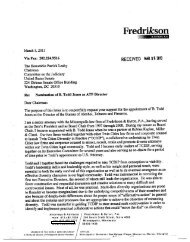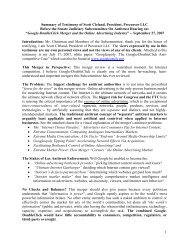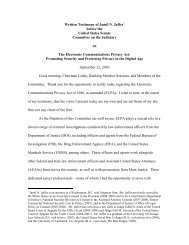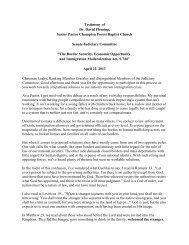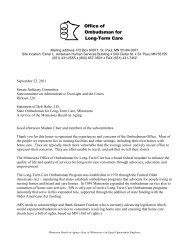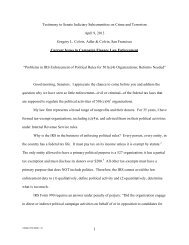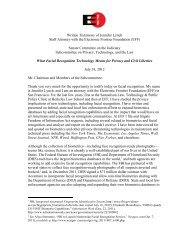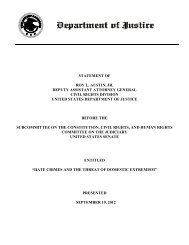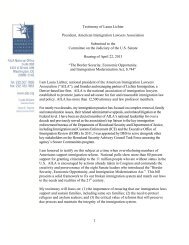CAMP LEJEUNE, NORTH CAROLINA - Senate Judiciary Committee
CAMP LEJEUNE, NORTH CAROLINA - Senate Judiciary Committee
CAMP LEJEUNE, NORTH CAROLINA - Senate Judiciary Committee
Create successful ePaper yourself
Turn your PDF publications into a flip-book with our unique Google optimized e-Paper software.
BASIC AIR SYSTEM<br />
PROCEDURES<br />
"Preliminary TAB Procedures" covered<br />
Ihe preparation work lhat must he done prior !o Ihe<br />
actual testing, adustiqg and bnlnnP.in.q of tile IVAC<br />
systems on the Job. Confirm Ilmt lhese peliminnry<br />
procedures have been completed and check lisls<br />
prepared. Do not attempt to balance a system before<br />
Installation has been completed and the system is<br />
ready to be balanced.<br />
The following balancing procedures are basic Io nil<br />
types of air systems.<br />
1) Confirm Ihat every ilem affecting tile aiHIow of a<br />
ducl system Is ready for tile TAB woJk, such as<br />
doors and windows being closed, ceiling liles<br />
(return plenums) in place, etc.<br />
2) Confirm Ihal all aulomalic control devices will<br />
not affecl TAB operations.<br />
3) Establish the conditions for Ihe maximum demand<br />
system airflow which generally is a cool-<br />
4)<br />
Ing application with "welled" coils.<br />
After verifying Ihal all dampers are open or set,<br />
sled all related systems (relurn, exhaust, etc.)<br />
and the system being balanced with each fan<br />
running al Ihe design speed (rpm). Upon start-<br />
Ing each fan, #Immdiately check 11m fnl reeler<br />
amperage. If lhe amperage exceeds lhe<br />
nameplale full load amperage, slap the fnn Io<br />
delermine lhe cause or Io make lhe necessary<br />
adjuslmenls.<br />
5) Again confirm Ilml 11 related syslPmfs|vleg<br />
each nrP.n wilhin Ihe space b.h|.q<br />
are operaltng. If Ihey are not, prn.ure differences,<br />
and Inlillrnlion or exfiltralion may adversely<br />
influence Ihe balancing. Pceliminnry<br />
studies will have revealed whether or not Ihe<br />
supply air quanlily exceeds lhe exhausl air<br />
qunnlily from each area. Positive and negalIve<br />
pressure zones should be Identified at the time.<br />
6) If a supply fan i. connected to a rolurn air syslem<br />
and an oulside air inlake, sot 11 syslem<br />
AIR SYSTEM AB<br />
PROCEDURES<br />
dampers and conlrols so that the air relurned<br />
from Ihe individual rooms or areas supplied by<br />
lhe fan is relurned via Ihe relaled relurn air<br />
syslem. Normally lhis will Involve opening an.<br />
o|lsidP, air damper Io the minimum position,<br />
opeling Ihe relum air damper, nnd closing<br />
exhnusl nit nnd relief air dampers. (If lhe supply<br />
syslem is nssocinled with a return air syslem<br />
nnd/or an independenl exhaust system, make<br />
mre nil syslems are opernling and all relaled<br />
dampers are sel properly for Ihe TAB work.)<br />
7) t3elermine the volume of air being moved by lhe<br />
supply fnn nl design rpm by one or more of lhe<br />
following melhods. The preferred methods are:<br />
a) Pilol lube lraverse of main duct or dcls<br />
leaving fan discha=ge.<br />
b) Fan curves (r fan performance chads. In<br />
order 1o delermine fan performance using a<br />
fan curve or performance rating chad, il is<br />
necessary Io take amperage and voltage<br />
readings. In addition, a slallc pressure read-<br />
Ing across lhe fan must be recorded. Wilh<br />
rpm, brake horsepower and static pressure,<br />
lhe fan mnnufacturer’s data sheets may be<br />
med Io delermlne Ihe aidlow (cfm) predid.led<br />
by Ihe Hnufaclurer. Fan perfbrrnnce<br />
cnn dUvinle from Ihe fan curves if<br />
"sy.lem effect" or olher syslem installalion<br />
defecls are present.<br />
c) Anemomeler readings across coils, fillers,<br />
ned/or dampers on the Inlnke side of the fan.<br />
1-hi i used ns an approxlmalion only.<br />
0) If Ihe spply fan voh=me is not within plus or<br />
minus 10% of the design capacity at design<br />
rpm, dtermine the reason by reviewing all syslem<br />
conditions, procedures and recorded dale.<br />
Check and record the air pressure drop across<br />
fillers, ’coils, eliminators, sound traps, elc., to<br />
see if excessive loss Is occurring. Paflicularly<br />
Iudy dcl and casing conditions at Ihe fan inlet<br />
and outlel.




